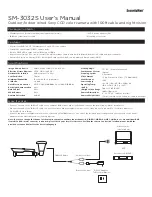
Handbook for SXV-M5 Issue 1 June 2004
9
image is sharp. When the mirror is raised, the image will fall onto the CCD surface
and should be accurately in focus. Most flip mirror units allow several adjustments to
be made, so that the image can be centred properly in the eyepiece and CCD fields,
which are not necessarily coincident when you first buy your unit!
Opinions vary as to the utility of flip mirrors. They are a convenient way to find and
focus, but they add quite a bit of extra length between the camera and telescope. This
can be very inconvenient with Newtonians, and not a lot better with SCTs, especially
if the assembly is somewhat flexible. They also make it difficult to use a focal reducer
with your camera, as the rapidly converging light cone from a reducer cannot reach all
the way through the flip mirror unit to the CCD surface. If you are using one of the
popular F3.3 compressors for deep sky imaging, you will NOT be able to include a
flip mirror unit in front of your camera and a par-focal eyepiece is your best option.
Whichever device you use, it is necessary to set up a good optical match between your
MX7 and the telescope. Most SCTs have a focal ratio of around F10, which is too
high for most deep sky objects and too low for the planets! This problem is quite easy
to overcome, if you have access to a telecompressor (for deep sky) and a Barlow lens
for planetary work. The new Meade F3.3 compressor is very useful for CCD imaging
and I can recommend it from personal experience. It does not require a yellow filter
for aberration correction, unlike some other designs, so it can be used for colour
imaging. Barlow lenses are less critical and most types can be used with good results.
However, if you are buying one for CCD imaging, I recommend a 3x or 5x amplifier,
or the planets will still be rather small in your images. As a guide, most CCD
astronomers try to maintain an image scale of about 2 arc seconds per pixel for deep
sky images. This matches the telescope resolution to the CCD resolution and avoids
‘undersampling’ the image, which can result in square stars and other unwanted
effects. To calculate the focal length required for this condition to exist, you can use
the following simple equation:










































